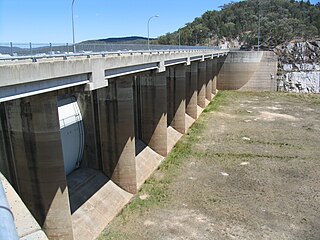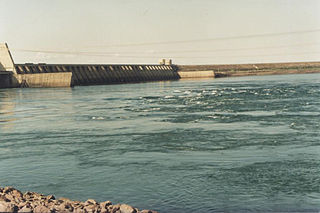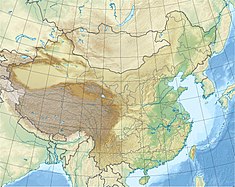
Copeton Dam is a major clay core and rock fill embankment dam with nine radial gates and a gated concrete chute spillway across the Gwydir River upstream of Bingara in the New England region of New South Wales, Australia. The dam's purpose includes environmental flows, hydro-electric power generation, irrigation, and water supply. The impounded reservoir is called Lake Copeton.
Windamere Dam is a minor ungated rock fill with clay core embankment dam with an uncontrolled unlined rock cutting spillway across the Cudgegong River at Cudgegong, upstream of Mudgee in the Central Tablelands of New South Wales, Australia. The dam's purpose includes hydro-power, irrigation, water supply, and conservation. The impounded reservoir is called Lake Windamere.

The Xiluodu Dam is an arch dam on the Jinsha River, i.e. the upper course of the Yangtze in China. It is located near the town of Xiluodu in Yongshan County of Yunnan Province but the dam straddles into Leibo County of Sichuan Province on the opposite side of the river. The primary purpose of the dam is hydroelectric power generation and its power station has an installed capacity of 13,860 MW. Additionally, the dam provides for flood control, silt control and its regulated water releases are intended to improve navigation downstream. Construction on the dam and power station began in 2005 and the first generator was commissioned in 2013, the last in 2014. It is operated by China Yangtze Power and is currently the fourth-largest power station in the world, as well as the fifth tallest dam world-wide.

Toonumbar Dam is a minor ungated rock fill with clay core embankment dam with a concrete chute spillway across the Iron Pot Creek north-west of Casino in the Northern Rivers region of New South Wales, Australia. The dam's purpose includes hydro-power, irrigation, water supply, and conservation. The impounded reservoir is called Lake Toonumbar.

The Badush Dam is an unfinished multi-purpose dam on the Tigris River, located near Badush, 16 kilometres (9.9 mi) northwest of Mosul in the Ninawa Governorate, northern Iraq.

The Siah Bisheh Pumped Storage Power Plant, also spelled Siyāhbisheh and Siah Bishe, is located in the Alborz Mountain range near the village of Siah Bisheh and 48 km (30 mi) south of Chalus in Mazandaran Province, Iran. The power plant uses the pumped-storage hydroelectric method to generate electricity during periods of high energy demand, making it a peaking power plant, intended to fulfill peak electricity demand in Tehran 60 km (37 mi) to the south. When complete it will have an installed generating capacity of 1,040 megawatts (1,390,000 hp) and a pumping capacity of 940 megawatts (1,260,000 hp). Planning for the project began in the 1970s and construction began in 1985. It was delayed from 1992 until 2001 and the first generator went online in May 2013. The remaining generators were commissioned by 1 September 2015. The power plant is the first pumped-storage type in Iran and will also use the country's first concrete-face rock-fill dam – two of them.
The Salto Osório Hydroelectric Power Plant is a dam and hydroelectric power plant on the Iguazu River near Osório in Paraná, Brazil. It is the second dam upstream of the Iguazu Falls and was completed in 1979. The power station has a 1,078 MW capacity and is supplied with water by a rock-fill embankment dam.
The Salto Santiago Hydroelectric Power Plant is a dam and hydroelectric power plant on the Iguazu River near Santiago in Paraná, Brazil. It is the third dam upstream of the Iguazu Falls and was completed in 1979. The power station has a 1,420 MW capacity and is supplied with water by a rock-fill embankment dam.
The Governor Bento Munhoz da Rocha Netto Hydroelectric Plant, formerly known as Foz do Areia, is dam and hydroelectric power plant on the Iguazu River near Foz do Areia in Paraná, Brazil. It is the furthest dam upstream of the Iguazu Falls and was constructed between 1976 and 1980. The power station has a 1,676 megawatts (2,248,000 hp) capacity and is supplied with water by a concrete face rock-fill embankment dam.

The Itumbiara Dam is an embankment dam on the Paranaíba River near Itumbiara in Goiás, Brazil. The dam serves an associated hydroelectric power plant with a 2,082 megawatts (2,792,000 hp) installed capacity. The power plant is the sixth largest in Brazil and has the largest installed capacity of Eletrobrás Furnas' power plants.
The Serra da Mesa Dam, once known as Sao Felix, is an embankment dam on the Tocantins River near Minaçu in Goiás, Brazil. The dam serves an associated hydroelectric power plant with a 1,275 megawatts (1,710,000 hp) installed capacity. The dam creates the largest reservoir by volume in Brazil.

The Engineer Souza Dias Dam, formerly known as the Jupiá Dam, is an embankment dam on the Paraná River near Três Lagoas in Mato Grosso do Sul, Brazil. It was constructed for hydroelectric power production, flood control and navigation. Studies on the dam and power plant began in 1951 which recommended the dam along with the Ilha Solteira Dam. The dam was inaugurated in 1968 and its generators were commissioned between 1969 and 1974.

The Água Vermelha Dam is an embankment dam on the Grande River near Iturama in Minas Gerais/São Paulo, Brazil. It was constructed for hydroelectric power production and flood control. Construction on the dam began in 1973 and it was completed and operational by 1978. The last generators were operational in 1979.

The Tianhuangping Pumped Storage Power Station is a pumped-storage power station in Tianhuangping, Anji County of Huzhou, Zhejiang Province, China. The power station has an installed capacity of 1,836 megawatts (2,462,000 hp) utilizing 6 reversible Francis turbines. Construction began in 1993 and the power station was completed in 2004.
The Liuxihe Dam is an arch dam on the Liuxi River in Conghua District, Guangzhou, Guangdong Province, China. The main purpose of the project is hydroelectric power generation with additional purposes of flood control and irrigation. The dam is 78 metres (256 ft) tall and was constructed between 1956 and 1958.
The Baishan Dam is an arch-gravity dam on the Second Songhua River near the town of Baishanzhen, Huadian, Jilin Province, China. The purpose of the dam is hydroelectric power generation and flood control. The dam supplies water to five turbine-generators in two different powerhouses for an installed capacity of 1,500 megawatts (2,000,000 hp) while it can also control a design 19,100 cubic metres per second (670,000 cu ft/s) flood. Additionally, it has a 300 megawatts (400,000 hp) pumped-storage hydroelectric generation capacity. It is named after Baekdu Mountain, near the city of Baishan.

The Aras Dam is an embankment dam on the Aras River along the border of Iran and Azerbaijan. It is located downstream of Poldasht in West Azerbaijan Province, Iran and Nakhchivan City in Nakhchivan Autonomous Republic, Azerbaijan. The primary purpose of the dam is hydroelectric power generation and water supply.

Zengwen Dam, also spelled Tsengwen Dam, is a major earthen dam in Dapu Township, Chiayi County, Taiwan on the Zengwen River. It is the third tallest dam in Taiwan, and forms Zengwen Reservoir (曾文水庫), the biggest reservoir in Taiwan by volume. The dam stores water for irrigation of the Chianan Plain, Taiwan's most productive agricultural region, and provides flood control along the Zengwen River which flows through Tainan City. The dam supports a 50 megawatt hydroelectric power station.

The Miel I Dam, officially known as the Patángoras Dam, is a gravity dam on La Miel River just south of Norcasia in Caldas Department, Colombia. The dam was constructed between 1997 and 2002 for the primary purpose of hydroelectric power generation. At the time of its completion, the dam was the tallest roller-compacted concrete (RCC) dam in the world but was surpassed by the Longtan Dam in 2009.
The Porce III Dam is an embankment dam on the Porce River 90 kilometres (56 mi) northeast of Medellín in Antioquia Department, Colombia. The dam was constructed between 2004 and 2011 for the primary purpose of hydroelectric power generation.












